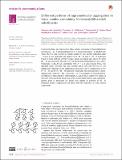Different patterns of supramolecular aggregation in three amides containing N-(benzo[d]thiazolyl) substituents
Abstract
Crystal structures are reported for three amides containing N-benzo[d]thiazole substituents. In N-(benzo[d]thiazol-6-yl)-3-bromobenzamide, C14H9BrN2OS, where the two ring systems are nearly parallel to one another [dihedral angle = 5.8 (2)°], the molecules are linked by N—H⋯O and C—H⋯N hydrogen bonds to form ribbons of R33(19) rings, which are linked into sheets by short Br⋯Br interactions [3.5812 (6) Å]. N-(6-Methoxybenzo[d]thiazol-2-yl)-2-nitrobenzamide, C15H11N3O4S, crystallizes with Z′ = 2 in space group Pna21: the dihedral angles between the ring systems [46.43 (15) and 66.35 (13)°] are significantly different in the independent molecules and a combination of two N—H⋯N and five C—H⋯O hydrogen bonds links the molecules into a three-dimensional network. The molecules of 5-cyclopropyl-N-(6-methoxybenzo[d]thiazol-2-yl)isoxazole-3-carboxamide, C15H13N3O3S, exhibit two forms of disorder, in the methoxy group and in the cyclopropylisoxazole unit; symmetry-related pairs of molecules are linked into dimers by pairwise N—H⋯N hydrogen bonds. Comparisons are made with the structures of some related compounds.
Citation
Mahesha , N , Yathirajan , H S , Nagma Banu , H A , Kalluraya , B , Foro , S & Glidewell , C 2021 , ' Different patterns of supramolecular aggregation in three amides containing N -(benzo[ d ]thiazolyl) substituents ' , Acta Crystallographica Section E Crystallographic Communications , vol. 77 , no. Part 5 , pp. 504-511 . https://doi.org/10.1107/S2056989021003637
Publication
Acta Crystallographica Section E Crystallographic Communications
Status
Peer reviewed
ISSN
2056-9890Type
Journal article
Description
HSY is grateful to the UGC, New Delhi, for the award of a BSR Faculty Fellowship for three years.Collections
Items in the St Andrews Research Repository are protected by copyright, with all rights reserved, unless otherwise indicated.

